Id, Ego & Superego do social distancing – II
This is week 10, so if you missed the adventures of Id, Ego & Superego in week 5 it’s to be found here. But I’m going to fill the rest of my post with some gratuitous lighthouse porn to try to boost the clickthrough rate for this blog to meet my performance indicators. Today we’ve a particularly classy offering for you though: a Class 1 Fresnel, to be sure:
It was only today that I realised that the “main event” of the lighthouse is not so much its structure (built on the island’s highest peak it couldn’t be too tall else the light would be obscured by fog or its beams would go over the heads of approaching mariners). Nor is it its 1000W lamp (though, as I mentioned in my last post, being powered by wind these days gives it an extra allure). No, it’s the lens.
 There are thousands of structures that fit the description of a “lighthouse” as a lamp-and-lens-based navigational aid, but the vast majority of these are very prosaic affairs, often no more than a lonely omnidirectional LED atop a metal gantry. It’s a much smaller subset of lighthouses that feature a rotating optical lens to focus the light such that it appears as an identifiable signature of flashes to seafarers, in this case three flashes per minute.
There are thousands of structures that fit the description of a “lighthouse” as a lamp-and-lens-based navigational aid, but the vast majority of these are very prosaic affairs, often no more than a lonely omnidirectional LED atop a metal gantry. It’s a much smaller subset of lighthouses that feature a rotating optical lens to focus the light such that it appears as an identifiable signature of flashes to seafarers, in this case three flashes per minute.
This realisation came, oddly enough, from photographing Utsira’s marching band on Norway’s national day last weekend. For an isolated island of 200 people they sport a very listenable band (especially considering that wind instruments, like choirs, can’t rehearse together indoors presently). Only as I looked in detail at my photographs today did I notice that the band’s blue standard features the lighthouse’s four primary beams prominently (below left). What’s more, the entire island’s white & blue flag is a stylised version of the same (below, right). With the addition of a few mysterious or esoteric rituals, this light-worship could form the basis of quite an exotic cult, attracting anthropologists from far and wide.
These symbols say a lot about the centrality of the lighthouse in the collective imagination of the (predominantly fishing-based) community here. And the islanders have good reason to be proud. Their fresnel is nothing less than a First Order lens (Eighth Order being the smallest), meaning that it can be seen over 30km away, and that it’s large enough to fit half a dozen people inside, in less socially-distanced times. Looking out from within, the landscape appears inverted; a curiously apt metaphor for a world turned upside-down in coronavirus times.
 French optical scientist Augustin Fresnel developed this lens system in the 1820s to enable brighter lighthouses. Large aperture and short focal length enabled his lenses to capture the lamp’s oblique light with their concentric rings of purest glass, magnifying its luminosity fourfold. Utsira’s was made by Frédéric Barbier in the fresnel factory at 82 Rue Curial, in Paris’ 19ème, in 1890. From its installation until the Germans occupied the island in 1944 it was rotated by clockwork. A large part of the light-keeper’s job besides glass-polishing was winding the counterweight chains back up during the day and greasing the wheels to enable it to glide around all night. The sound of the lighthouse clockwork system operating must have been extraordinary.
French optical scientist Augustin Fresnel developed this lens system in the 1820s to enable brighter lighthouses. Large aperture and short focal length enabled his lenses to capture the lamp’s oblique light with their concentric rings of purest glass, magnifying its luminosity fourfold. Utsira’s was made by Frédéric Barbier in the fresnel factory at 82 Rue Curial, in Paris’ 19ème, in 1890. From its installation until the Germans occupied the island in 1944 it was rotated by clockwork. A large part of the light-keeper’s job besides glass-polishing was winding the counterweight chains back up during the day and greasing the wheels to enable it to glide around all night. The sound of the lighthouse clockwork system operating must have been extraordinary.

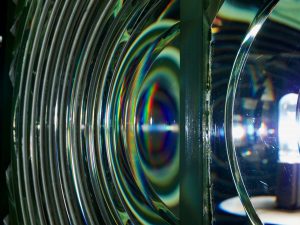
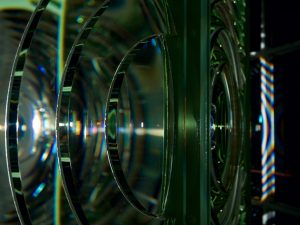
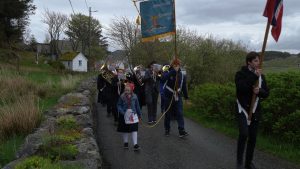
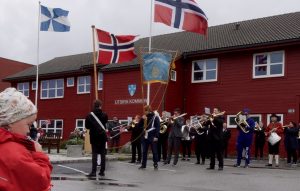
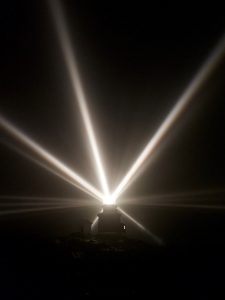
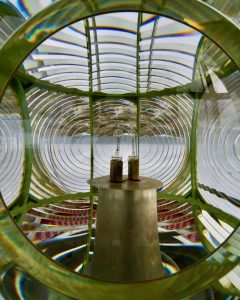

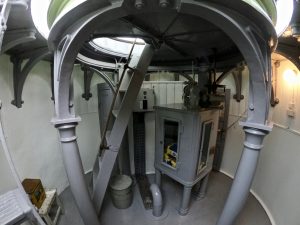
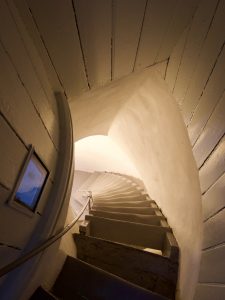

Brilliant – from all perspectives
Thanks Adam